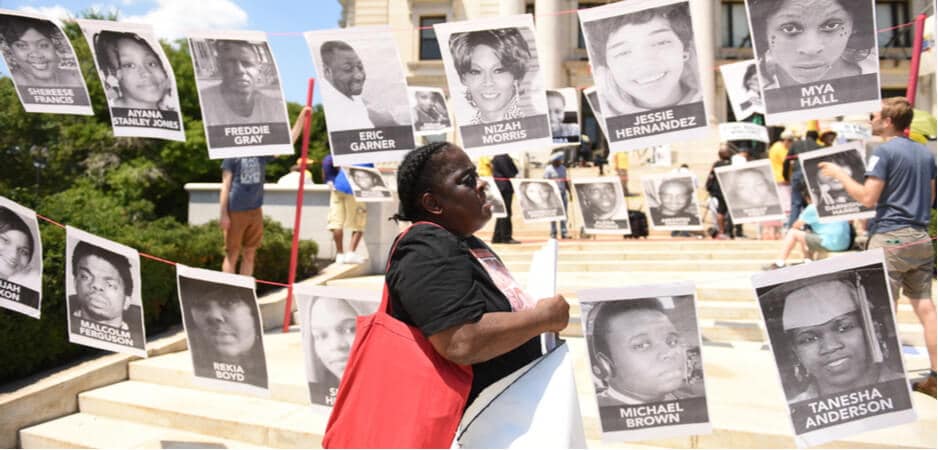In this edition of The Interview, Fair Observer talks to Dr. Tsedale Melaku, a critical race and gender scholar at the City University of New York.
The United States thrives on being a multicultural and diverse society that guarantees individual freedoms and rights to all its citizens. However, even though the brutal institution of slavery and the era of racial segregation are a thing of the past, there are indications that systemic racism hasn’t gone away and still haunts American society.
In 1967, the National Advisory Commission on Civil Disorders, known as the Kerner Commission, which was tasked by President Lyndon B. Johnson to probe the causes of the 1967 race riots and come up with recommendations for the future, concluded that the United States was “moving toward two societies, one black, one white — separate and unequal.” Almost half a century after those protests and despite the progress made, America is still a land of inequalities. According to Pew Research, 92% of African Americans think that “whites benefit at least a fair amount from advantages that blacks do not have,” and 68% say that whites “benefit a great deal.”
People of color in the United States face serious difficulties in securing education, employment, health care and quality housing. They have long been grappling with discrimination and profiling by law enforcement. It goes without saying that the criminal justice system is also substantially biased against people of color, and African Americans in particular. This is evidenced by figures showing that despite making up only 13% of the general population, African Americans constitute 40% of the prison population in the United States.
Many thought that the election of Barack Obama to the presidency would be a turning point for race relations. But talking points about a post-racial America were hushed by a wave of police brutality across the country that gave rise to the Black Lives Matter movement and sparked violent protests in cities like Baltimore and Ferguson reminiscent of the civil rights era. Today, under Obama’s successor President Donald Trump, America is hardly a color-blind, tolerant society. Hate crimes have been on the rise since Trump’s coming to power. White supremacists have been emboldened, and anti-immigrant rhetoric has become more widespread.
Dr. Tsedale Melaku is a sociologist, critical race and gender scholar, and post-doctoral researcher at the Institute for Research on the African Diaspora in the Americas and the Caribbean at the City University of New York. Her latest book, You Don’t Look Like a Lawyer: Black Women and Systemic Gendered Racism, was published earlier this year.
In this edition of The Interview, Fair Observer talks to Tsedale Melaku about race relations in America today, the Black Live Matter movement and the stereotypes that still engulf the question of race.
The text has been lightly edited for clarity.
Kourosh Ziabari: Some scholars I’ve talked to are of the opinion that it’s not easy being black in 21st-century America, and that racism is an obstacle to the black Americans’ access to quality education, health care, housing and job opportunities. Do you agree?
Tsedale Melaku: The pervasiveness of structural racism is clearly evident in the multitude of studies that indicate the wealth gap between white and black households play a critical role in how American families are able to obtain employment, housing, quality health care, education and economic upward mobility. Just looking at the poverty rate in varying neighborhoods demonstrates significant racial disparities between black and white children.
For example, the average middle-income black child resides in a neighborhood with a higher poverty rate as compared to a low-income white child. This significantly affects the life chances of black children. Another example of where hardship can be evidenced is through the recent article by sociologists Melvin E. Thomas, Richard Moye, Loren Henderson and Hayward Derrick Horton. In this study, they examine the combined effects of race, class and residential segregation on housing values for blacks versus whites resulting from the 2008 and 2009 Great Recession.
In addition to these factors and many more, I think the political climate we are in has not made it easy for people of color as a whole, but black people in particular, to live their everyday lives without the constant threat of structural, symbolic or physical violence that may be visited upon them through unfair policies and practices in place that continue to block access to necessary resources. So yes, I do agree that being black in America is still not easy, and will not get any easier until we address systemic issues of racism, sexism and classism.
Ziabari: How is it possible to debunk the myths and stereotypes that generate gendered racism and create barriers to African American women’s employment and professional development? What is the role of the media in perpetuating or downplaying these stereotypes?
Melaku: First, we need to acknowledge that these stereotypes and myths are part of a broader narrative created to keep marginalized groups in subordinate positions. Understanding that a white racial frame — an extensive viewpoint including racial stereotypes, assumptions, narratives and interpretations embedded within the minds of whites that people of color can also adopt — views whites as superior and the racially oppressed as inferior. This frame is used to justify continued white privilege and dominance.
My book, You Don’t Look Like a Lawyer: Black Women and Systemic Gendered Racism, based on extensive interviews with black women lawyers, highlights how race and gender create barriers to their recruitment, professional development and advancement to partnerships in elite corporate law firms. Through in-depth analysis I discuss how their experiences center around systemic gendered racism embedded within institutions. The book covers topics including appearance; white narratives of affirmative action; the differences and similarities with white women and black men; exclusion from social and professional networking opportunities — the “Boys’ Club” — and the lack of mentors, sponsors and substantive training. I work to highlight the often-hidden mechanisms elite law firms utilize to perpetuate and maintain a dominant white male system. Black women’s social identity creates unique daily racial and gendered microaggressions, which also manifest in their professional, social and economic development.
This is key when thinking about the ways in which black women, and other women of color, face significant challenges conforming to and maintaining a dominant Eurocentric aesthetic in the workplace, as well as how this white racial framing impacts the perceived ability, competence and subsequent recruitment, training, development and promotion of this demographic.
The image of a lawyer does not invoke the image of a black woman because media representations of professional people tend to be white, and mostly male. Only recently have we begun to see images of black women in powerful lawyer positions in the media thanks to Shonda Rhimes, like Olivia Pope or Annalise Keating, but there continues to be a disconnect between media representations and actual perceptions of black women’s reality.
Ziabari: In recent years, there were several instances of US police using violence against and mistreating African American men and, in cases like that of Eric Garner, Michael Brown and E. J. Bradford, killing them. Do you think the law enforcement system in the United States is particularly biased against black citizens?
Melaku: The police shooting of any person should concern all people, and we need to ensure that the people who are in a position to protect and serve are doing just that. Countless studies have shown that there is significant bias in law enforcement that makes people of color, and black men in particular, vulnerable. For example, the work of Gaurav Jashnani, Priscilla Bustamante and Brett G. Stoudt examines how order maintenance policing approach — also linked to “broken windows” policing — incorporated by urban law enforcement has a disproportionate impact on the experiences of low-income people of color.
The lived experience of people of color is centered in this research to evidence how stops, ticketing and arrests by urban law enforcement negatively affect communities of color, leading to unwanted criminal identities that continue to pathologize black and brown people and push them out of public space. I strongly urge that we continue to have a dialogue with law enforcement agencies, lawmakers and government officials about the seemingly unaddressed violence, policies and practices that are visited upon marginalized groups, and black people in particular.
Ziabari: Has the Black Lives Matter movement been able to fulfill its goals, including bringing anti-black racism to the attention of politicians and combating racial inequality, profiling and police brutality? What’s your assessment of what this movement has gained in the years since its founding?
Melaku: The Black Lives Matter movement is a broad-based social movement that works toward campaigning against systemic racism that disadvantages black people actively pursuing human rights through a variety of ways, including advocacy, activism, education and consciousness raising, among others. The movement attempts to publicize often unrecognized challenges black people encounter, ranging from poverty, racial profiling, gender violence, mass incarceration and various other forms of racial inequality in the US.
More research is needed to understand the importance of the movement in highlighting the disparities black men and women face in America. While this is outside my field of expertise, existing academic work is being done to understand the successes and opportunity arising from the Black Lives Matter movement. Scholars such as Dr. Barbara Ransby, Dr. Frederick C. Harris, Dr. David Pate and Dr. Waldo E. Johnson, Jr., work to engage real conversations about the Black Lives Matter movement and the long historical reasoning behind the disparities reflected in the black experience and what could be done to make changes.
Ziabari: Are you concerned about the spillover of anti-black attitudes from the United States to other countries? In October 2016, a United Nations working group issued a warning about systemic anti-black racism in the criminal justice of Canada. What’s your take on that?
Melaku: Without question there will always be concern about the political response of the United States and what that means for its citizens at home and abroad, as well as people of color in other countries. As a powerful and influential leader in the world, it is our responsibility to ensure that we are always working toward equality and justice for all people. We need to hold true to the principles that we espouse. Black and brown people across the US and beyond protest due to the persistent frustration and anger over pervasive institutional and individual discriminatory practices they face on a daily basis which is fueled by growing anti-black sentiments.
Ziabari: How do you think the artists, media personalities, journalists and academicians can contribute to addressing racism and eradicating different forms of discrimination against people of color?
 Melaku: I think all of us need to engage in more critical discussions about the implications of our actions and particularly the ways in which systemic racism penetrates all institutions, creating unjust and unequal outcomes for people of color. In addition, there has to be the recognition that this is work that should not only fall on the shoulders of people of color, but all people, because this is a human rights issue. Further, people who are in positions of power should use their influence in order to move the needle further toward reaching more substantive changes in the lives of people who are disproportionately affected by systemic racism and its impact on their social, professional, educational and economic life chances.
Melaku: I think all of us need to engage in more critical discussions about the implications of our actions and particularly the ways in which systemic racism penetrates all institutions, creating unjust and unequal outcomes for people of color. In addition, there has to be the recognition that this is work that should not only fall on the shoulders of people of color, but all people, because this is a human rights issue. Further, people who are in positions of power should use their influence in order to move the needle further toward reaching more substantive changes in the lives of people who are disproportionately affected by systemic racism and its impact on their social, professional, educational and economic life chances.
Ziabari: A recent Government Accountability Office report found that black students in K-12 schools in the United States are far more likely to be disciplined for different types of maltreatment than those of other races. Does this indicate that racial inequality in the United States starts in the schools?
Melaku: This is a great question that many scholars have taken up within their research in various ways. Take the work of Dr. Carla Shedd for example. She published a very important book, Unequal City: Race, Schools, and Perceptions of Justice, that provides an incredibly in-depth analysis of how class stratification, racial residential segregation and disinvestment in public goods such as education, social support, etc., in Chicago have deleterious effects on the life chances of adolescents. Dr. Shedd particularly highlights how schools either emphasize or improve the varying social inequalities that shape the lives of students from marginalized backgrounds.
In contrast, my research focuses on schools as paths to mobility instead of pipelines to prison. Racial inequality does not begin, nor does it end, in schools. The black women I study earn positions in top law firms because of their academic successes, but racial and gendered inequality persists even in those contexts, which speaks directly to the systemic nature of racist and sexist practices embedded within varying forms of institutions.
Ziabari: According to a NBC News/SurveyMonkey poll, two-thirds of Americans believe racism remains a “major problem” in society. Only 3% of respondents said they believe racism doesn’t exist in the United States. To what extent does racism affect social relationships in America today?
Melaku: It is important for us to look at history, and the history of race and ethnicity in particular, when attempting to understand the current cultural, social, political and economic climate in the United States. We are a nation of immigrants, built on indigenous people’s land and stolen people’s labor, with a distinctive history of controlling migration according to racial and ethnic framing and preferences. In recognizing this history, we must come to accept that the optimistic and often rosy image of US equality and freedom glosses over continuing discriminatory practices embedded and widespread in institutions, from housing, employment, education, political and economic structures.
Social relationships are driven by the ways in which race, gender, class and other important identities intersect, combine or overlap to either privilege those in positions of power or oppress those viewed as inferior. As evidenced in my research, the way social identity affects the experiences of women and people of color is indicative of the fact that we still have a long way to go. This dynamic significantly impacts social relationships in America today, as [it has] in the past.
The views expressed in this article are the author’s own and do not necessarily reflect Fair Observer’s editorial policy.
Support Fair Observer
We rely on your support for our independence, diversity and quality.
For more than 10 years, Fair Observer has been free, fair and independent. No billionaire owns us, no advertisers control us. We are a reader-supported nonprofit. Unlike many other publications, we keep our content free for readers regardless of where they live or whether they can afford to pay. We have no paywalls and no ads.
In the post-truth era of fake news, echo chambers and filter bubbles, we publish a plurality of perspectives from around the world. Anyone can publish with us, but everyone goes through a rigorous editorial process. So, you get fact-checked, well-reasoned content instead of noise.
We publish 2,500+ voices from 90+ countries. We also conduct education and training programs
on subjects ranging from digital media and journalism to writing and critical thinking. This
doesn’t come cheap. Servers, editors, trainers and web developers cost
money.
Please consider supporting us on a regular basis as a recurring donor or a
sustaining member.
Will you support FO’s journalism?
We rely on your support for our independence, diversity and quality.






